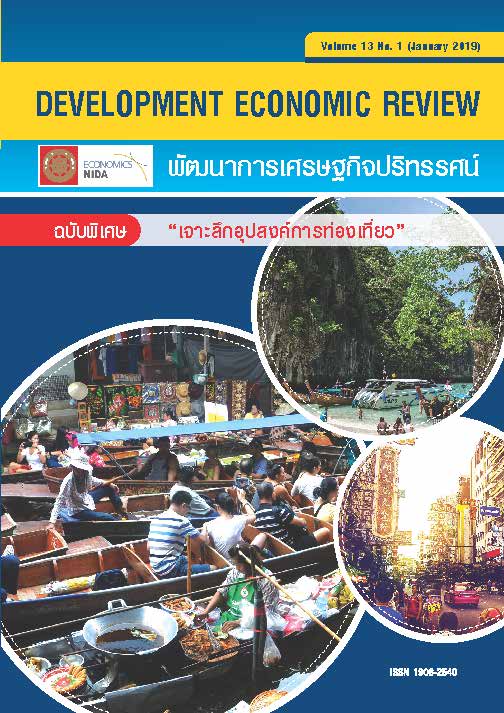On the Causal Nexus between Terrorism and Tourism: Empirical Evidence from the South Thailand Insurgency
Main Article Content
Abstract
The causal relationship between terrorism and tourism has long been debated in the literature. Using official monthly statistics on the number of death and casualty from South Thailand insurgency and the number of tourists entering the southern provinces of Thailand from January
2004 to June 2018, the causality between the two variables using the Autoregressive Distributed Lag model (ARDL) and Error Correction Model (ECM) are examined. Estimation results are in accord with other findings in the literature that terrorism has a negative causal impact on tourism in general. The study also finds a very strong evidence of mutual Granger causality that the number of tourists also affects the incidents of insurgency, a striking result that distinguishes this study from many others. In particular, an increase in the number of tourists
tends to decrease the incidence of insurgency, and that the estimated adjustment coefficient to the long run equilibrium is unusually high. The result partly uncovers the probable motive of the terrorists in Deep South Thailand that they may seek to create domestic disturbance while
minimizing conflict with other countries.
Article Details
Copyright to published manuscripts becomes the property of the Graduate School of Development Economics, National Institute of Development Administration. Reproduction of all or part of a Development Economic Review (DER) article by anyone, excluding author(s), is prohibited, unless receiving our permission.
Disclaimer: Opinions expressed in articles published in this journal are those of the author (s) and do nto necessarily represent opinions of the Graduate School of Development Economics, National Institute of Development Administration. Trade and proprietary names are only for identification and not constitute our endorsement.
References
Cline, L.E. (2007). Thailand and the insurgency in the south. Small Wars & Insurgencies, 18(2), 275-287.
Concepcion, S., Digal, L., Guiam, R., De La Rosa, R., & Stankovitch, M. (2003, December). Breaking the links between economics and conflict in Mindanao, Waging Peace’Conference, Manila.
Diebold, F.X. (1993). Discussion: The effect of seasonal adjustment filters on tests for a unit root. Journal of Econometrics, 55(1-2), 99-103.
Drakos, K. &Kutan, A.M. (2003). Regional effects of terrorism on tourism In three Mediterranean countries. Journal of Conflict Resolution, 47(5), 621-641.
Enders, W.& Sandler, T. (1991). Causality between transnational terrorism and tourism: the case of Spain.Studies in Conflict & Terrorism, 14(1), 49-58.
Enders, W., Sandler, T., &Parise, G.F. (1992). An econometric analysis of the impact of terrorism on tourism. Kyklos, 45(4), 531-554.
Feridun, M. (2011). Impact of terrorism on tourism in Turkey: empirical evidence from Turkey. Applied Economics, 43(24), 3349-3354.
Funston, N.J. (2008). Southern Thailand: the dynamics of conflict (Vol. 50). Institute of Southeast Asian Studies, Chulalongkorn University.
Ghysels, E. (1990). Unit-root tests and the statistical pitfalls of seasonal adjustment: The case of US postwar real gross national product. Journal of Business & Economic Statistics, 8(2), 145-152.
Ghysels, E.&Perron, P. (1993). The effect of seasonal adjustment filters on tests for a unit root. Journal of Econometrics, 55(1-2), 57-98.
Kripfganz, S. & Schneider, D.C. (2018). ARDL: estimating autoregressive distributed lag and equilibrium correction models. In London Stata Conference 2018 (No.09). Stata Users Group.
Krueger, A.B.&Malečková, J. (2003). Education, poverty and terrorism: Is there a causal connection?. Journal of Economic Perspectives, 17(4), 119-144.
Lapan, H.E.& Sandler, T. (1993). Terrorism and signaling. European Journal of Political Economy, 9(3), 383-397.
Llusa, F.& Tavares, J. (2007). The economics of terrorism: a synopsis. The Economics of Peace and Security Journal, 2(1), 71-76.
Maddala, G.S., & Kim, I.M. (1998). Unit roots, cointegration, and structural change (No.4). Cambridge University Press.
Ministry of Tourism and Sports (2015). Annual report. Retrieved from www.mots.go.th
Morley, B. (2006). Causality between economic growth and immigration: An ARDL bounds testing approach. Economics Letters, 90(1),72-76.
Narayan, P.K., & Smyth, R. (2004). The relationship between the real exchange rate and balance of payments: Empirical evidence for China from cointegration and causality testing. Applied Economics Letters, 11(5), 287-291.
Narayan, P.K., & Smyth, R. (2005). Electricity consumption, employment and real income in Australia evidence from multivariate Granger Causality Tests. Energy Policy, 33(9), 1109-1116.
Pesaran, M.H., Shin, Y., & Smith, R.J. (2001). Bounds testing approaches to the analysis of level relationships. Journal of Applied Econometrics, 16(3), 289-326.
Rittichainuwat, B.N., &Chakraborty, G. (2009). Perceived travel risks regarding terrorism and disease: the case of Thailand. Tourism Management, 30(3), 410-418.
